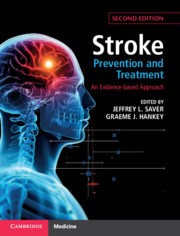Book contents
- Stroke Prevention and Treatment
- Stroke Prevention and Treatment
- Copyright page
- Dedication
- Contents
- Contributors
- Preface
- Part I Foundations
- Part II Systems of Care
- Part III Acute Treatment of Ischaemic Stroke and Transient Ischaemic Attack
- Part IV Acute Treatment of Haemorrhagic Stroke
- Part V Prevention
- Part VI Stroke Rehabilitation and Recovery
- Chapter 23 Evidence-based Motor Rehabilitation after Stroke
- Chapter 24 Language and Cognitive Rehabilitation after Stroke
- Chapter 25 Using Pharmacotherapy to Enhance Stroke Recovery
- Chapter 26 Electrical and Magnetic Brain Stimulation to Enhance Post-stroke Recovery
- Index
- References
Chapter 25 - Using Pharmacotherapy to Enhance Stroke Recovery
from Part VI - Stroke Rehabilitation and Recovery
Published online by Cambridge University Press: 15 December 2020
- Stroke Prevention and Treatment
- Stroke Prevention and Treatment
- Copyright page
- Dedication
- Contents
- Contributors
- Preface
- Part I Foundations
- Part II Systems of Care
- Part III Acute Treatment of Ischaemic Stroke and Transient Ischaemic Attack
- Part IV Acute Treatment of Haemorrhagic Stroke
- Part V Prevention
- Part VI Stroke Rehabilitation and Recovery
- Chapter 23 Evidence-based Motor Rehabilitation after Stroke
- Chapter 24 Language and Cognitive Rehabilitation after Stroke
- Chapter 25 Using Pharmacotherapy to Enhance Stroke Recovery
- Chapter 26 Electrical and Magnetic Brain Stimulation to Enhance Post-stroke Recovery
- Index
- References
Summary
Pre-clinical studies provide clear and consistent evidence that a variety of centrally acting drugs affecting specific neurotransmitters can either facilitate or interfere with functional recovery after brain injury. Although at least some clinical trials suggest similar effects in humans, results have been inconsistent. The impact of important factors such as drug dose, duration, and intensity of physiotherapy, and timing between injury and treatment are difficult to translate from preclinical studies. Issues related to variability in stroke severity, location of injury, and comorbid conditions further complicate trial design and could obscure a true treatment effect. Because of these and other issues, the design of efficacy trials assessing putative neuro-restorative interventions is not trivial. Although a proven pharmacological approach resulting in a clinically meaningful improvement in post-stroke recovery remains elusive, it is reasonable to avoid medications that may have harmful effects in patients who have had a stroke. It is also important to control for these possible harmful effects in future clinical trials assessing the outcomes of stroke patients after the acute period.
Keywords
- Type
- Chapter
- Information
- Stroke Prevention and TreatmentAn Evidence-based Approach, pp. 517 - 531Publisher: Cambridge University PressPrint publication year: 2020



